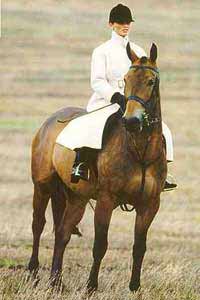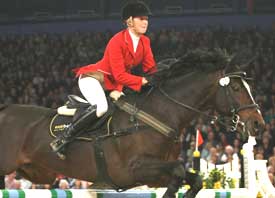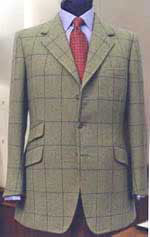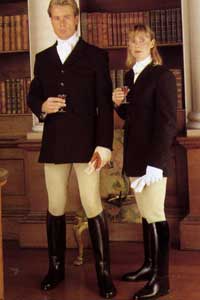THE CLOTHES HORSE SETS THE PACE
The motor car may dominate the modern scene but apart from the dubious distinction of the car coat (forever associated with shady second hand car dealers), it has inspired little in the way of elegant clothing. But the car’s forerunner, the horse, and horsey activities, undoubtedly inspired a major part of the modern male wardrobe. Indeed, noted costume historian,  James Laver, maintained that almost every article of male attire derives from the hunting clothes of England in the late 18th century. James Laver, maintained that almost every article of male attire derives from the hunting clothes of England in the late 18th century.
That was when hunting and riding as a sport developed, and the fashionable young rider of the times found that his embroidered coat, lace ruffles, silk stockings and tricorne hat ill-suited riding pell-mell after a fox. A simple cloth coat became adopted, cut away at the fronts for freedom and comfort in the saddle. Breeches replaced the hose, boots protected the legs and a hard high-crowned hat was designed to save the head.
The aristocratic Englishman of that time was unique in Europe in that he preferred his country estate, and outdoor, sporting activities, to court life. His clothes reflected this. And these clothes were by no means restricted to wearing in the country. Coke of Norfolk, a noted figure of the late 18th and early 19th centuries ( whose name  was later applied to the hard hat that became more popularly known as the bowler) wore his country clothes to Court when addressing George lll in favour of independence for the American Colonies. was later applied to the hard hat that became more popularly known as the bowler) wore his country clothes to Court when addressing George lll in favour of independence for the American Colonies.
He may not have persuaded George lll but his clothes made enough of an impression to inspire the Regency dandies – who adopted a trimmer, smarter version of the country styles. It was the simplicity of these clothes that encouraged more sophisticated cut and fit – for, as Beau Brummell appreciated (see preceding page), to stand out amongst others wearing similarly plain and simple clothes called for the very best of tailoring and grooming.
By the beginning of the 19th century, the sporting clothes worn in the countryside had become the norm for city wear too. And the practicality of those clothes, from hard wearing cloth, fit-for-purpose design and quality of make, were the basis for the style developments that followed.
At top, the riding mac, taken up by every international designer, here from Barbour; the outfit worn by showjumper Ellen Whitaker, above, illustrates the tailored fit and attractiveness of riding wear; below, classic tweed country jacket by Dege & Skinner.
These were spurred by the fact that the early sporting/horsey clothes became increasingly formal styles by the latter part of the 19th century - the tailcoat, for example, is still the most formal garment in the male wardrobe. So new sporting clothes were required,which lead to the hacking  jacket, roomy trousers, the lounge suit – initially for country wear and now itself formalised – the riding macintosh, the Tattersall check shirt and the covert coat. jacket, roomy trousers, the lounge suit – initially for country wear and now itself formalised – the riding macintosh, the Tattersall check shirt and the covert coat.
Huntsmen who hacked to the covert side wore Venetian twill coats in the early days, and these became known as Covert coats and the cloth as Covert. Initially, these were usually thigh length and fairly lightweight for riding. The Covert cloth gave a waterproof finish by being proofed before weaving.
Hunting is responsible for employing many outside its immediate concerns, and there was much concern that the recently imposed ban on hunting foxes with dogs would have a devastating effect. Happily, this has proved not to be the case, with most hunts carrying on hunting, albeit with no intention of killing a fox - it is maintained.
 Gymkhanas start ‘em young, children as young as four taking their ponies over appropriate jumps, while horse shows and point-to-point races provide scope for other get-togethers, and not just for riders. And of course racing and breeding are major industries that account for considerable revenue. And all of these activities have established standards of dress for participants and spectators, which remain popular because of their wearability. Gymkhanas start ‘em young, children as young as four taking their ponies over appropriate jumps, while horse shows and point-to-point races provide scope for other get-togethers, and not just for riders. And of course racing and breeding are major industries that account for considerable revenue. And all of these activities have established standards of dress for participants and spectators, which remain popular because of their wearability.
Classic riding clothes, with well fitted jacket, over fitted riding breeches, high riding boots, stock-collared shirt and hard peaked hat is one of the most attractive of ensembles – as shown in this elegant couple, left.
For spectators, a tweed hacking jacket and cord trousers are favoured by the more relaxed of the country fraternity, though jeans have replaced many cord and moleskin traditionals; for the breeders and racing crowd, tweed suits are preferred, with Tattersall check shirt and perhaps a vest, plus tweed or felt trilby hat.
The British took many of these horsey pastimes with them around the world, during the days of the Empire. So Hong Kong, Malaysia, Singapore, Australia and India have long established and well regulated racing programmes.
|